I love wildlife, even predators. Yes, it’s true, despite the fact that I keep small livestock which are vulnerable to predation by a long list of wild animals that thrive around my backyard farm, I enjoy seeing them, even on “my property” (I hate calling it that…it’s their property, too, isn’t it?) And, yes, I have lost a few chickens to predators, but no, it didn’t inspire anger, fear, or hatred, and I never felt any desire to “get even”. I’m committed to co-existing peacefully with wildlife, and will eventually post about how I do it. The shy, elusive, adaptable, and beautiful Lynx rufus, is one of my favorites. In this post I summarize a few of my experiences tracking bobcats, provide a little how-to lesson in identifying bobcat tracks, trails, and scent marking behavior, and summarize bobcat ecology to help you figure out where to find them.
One February morning in 2006, about week after a few inches of powdery snow had fallen, I went scouting around a beaver wetland in Harvard, MA. I was hoping to find tracks of fox, which I had smelled there on a previous outing, and otter, whose scat I had seen there, days before. But within minutes after stepping onto the ice, I noticed something even more interesting, standing out from among the deer, coyote, and squirrel tracks: a trail of feline footprints.
Because conditions were not great for tracking – a thin, crunchy crust covered several inches of powdery substrate – the tracks were far from crispy clear, yet the typical feline foot morphology could be seen: four toes on each roundish foot with asymmetric toe arrangement, and a somewhat trapezoidal shape to the palm pad with a bi-lobed leading edge. And there were no claw marks, which is typical of bobcat tracks, since these animals usually retract their claws while walking. The bobcat track photos below are not from this outing, but show these characteristics.
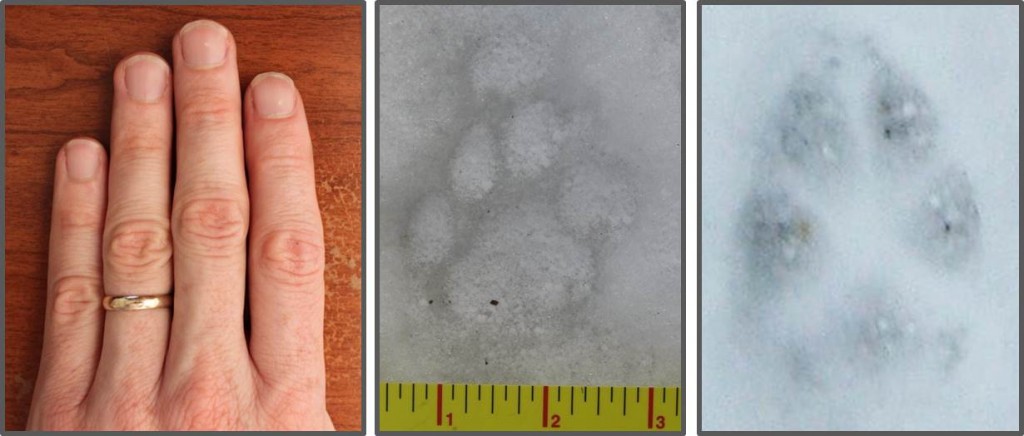
Bobcat paw (center track) shows same asymmetry of digit arrangement as human hand. Compare to coyote track (right) with symmetric arrangement of toes.
Canid (dog, fox, coyote, and wolf) tracks tend to be oval, the toes are more symmetrically arranged, and the palm pad more is triangular and smaller, relative to the overall size of the track. And because canids cannot retract their claws, nail marks are often noticeable in the track.
The feline footprints I found way back in that 2006 outing were on the small side for a bobcat, only about 1.5 inches wide. And although I could not rule out house cat based on that size, I knew at once that it was no house cat. This was based on the stride and straddle measurements of the particular gait – an alternating walk – that the animal was using.
The step length averaged only about 13-14 inches, and a house cat can actually achieve that length if it is trotting rather than walking. But when an animal trots, the trail width narrows, and a trotting house cat would have a trail width of less than 4 inches. The width of the trail I had just discovered averaged about 5-6 inches. That’s way too wide for a trotting house cat. This was a trail of a larger animal moving slowly, rather than a small animal moving quickly. A walking bobcat.
Sometimes you can distinguish bobcat from house cat, based on track size alone In his book Mammal Tracks and Sign, Mark Elbroch lists house cat track width as ranging from 7/8 of an inch to 1 ¾ of an inch. I’ve found that unless the cat is splaying its toes, as it might do in soft mud, the tracks of even large male house cats rarely exceed 1 ½ inches in width. I have two large male cats (15 lbs lean body weight, in their prime), and their tracks in snow are about 1 ¼ inches wide.
Bobcat track width, says Elbroch, ranges from 1 3/16 inches to 2 5/8 inches. Bobcat body size varies regionally, and obviously larger individuals will have larger feet. Here in Massachusetts, I find that bobcat track width is usually 1 ½ – 2 ¼ inches. When I see big, perfect, 2 inch cat tracks where the toes are clearly not splayed, I don’t get down on the ground to measure it out, but I do take measurements when the diagnosis is not crystal clear. Here’s a summary of bobcat and house cat track and trail measurements.

Bobcat and house cat track and trail measurements. Trail measurements for alternating gait only. Based partly on my experience, and partly on Mammal Tracks and Sign, by Mark Elbroch.
Bobcats often use an alternating walking pattern when moving about, but they like to pause frequently to study their surroundings. If you’re lucky, you might find a sit down print in the snow. I found the one in the photo at the edge of a hayfield, near the woods.
While I have found bobcat tracks many times since then, that moment in 2006 was particularly exciting because it was one of the first bobcat discoveries I made on my own. It’s not the easiest animal to find. Bobcats are not uncommon in central and western Massachusetts, but they are generally solitary and each individual requires a large home range. What this means is that they are sparsely distributed, so you can’t expect to come across them very often. Even in the best of habitats in southern climes, where food is abundant and life is relatively easy, you’re not likely to have more than one bobcat per square mile. At the other extreme, there may be only 1 bobcat per 35 square miles in northern New England.
But if you know where to look, you can find them…Or at least their tracks. Search for bobcat footprints where there is a mosaic of field, forest, and wetland, because a diversity of habitats usually means a diversity of prey, and this feline has a varied diet. Your best bet is at the edge between two different habitat types, especially if there is plenty of shrubby cover for rabbits (a favorite prey species) and other small mammals. In some areas, bobcats use the nooks and crannies between rocks for shelter, so you might find their tracks in boulder fields or on cliffy ledges. Where there is no rocky refuge, they will use thickets, brush piles and hollow logs for cover. Around here, I have found that wherever rabbits are abundant, a bobcat is likely to be patrolling the area, no matter what the available cover type. For further information on bobcat ecology, I highly recommend Kevin Hansen’s book, Bobcat: Master of Survival.
Last winter, we found a trail of bobcat tracks with interesting drag marks in the snow. We followed the trail through some dense brush, and discovered exactly what had caused the drag marks: a cottontail rabbit hanging from the cat’s mouth. All that remained of the rabbit were the intestines and some fur. The double zig-zag pattern of the drag marks were created by the rabbit’s two hind feet, as it swung from side to side with the cat’s movement. Check out this video to see exactly what I mean.
Prints are not the only sign of bobcat presence. Like unneutered house cats, bobcats spray urine backwards onto objects, such as a tree stump or the vertical face of a stone or ledge. Under rock overhangs, they also scrape leaf litter into little mounds, upon which they spray urine, but I have seen this only once or twice. Decaying stumps, on the other hand, are very common targets so if you come across one on a bobcat trail, get down on all fours and sniff away.
It smells just like house cat urine, and you’ll find the spot of greatest intensity to be about a foot off the ground. And don’t stop after finding one; these cats will often spray several stumps within a hundred yards. This is typical bobcat scent marking behavior.
Bobcats don’t leave scat as frequently as urine, but when they do scat, they usually leave it uncovered, in contrast to our house cats who cover it up in the litterbox. Bobcats often leave it right out in the open in well-traveled, visible locations, such as trail junctions.
I have read that with both hind feet, they sometimes prepare a scrape to receive the scat, but I have not observed this. The scat usually appears segmented but unlike canid and other predator scat, bobcat scat is does not usually appear twisted.
About a month ago, I was lucky enough to see a bobcat close to where I photographed that trail with the drag marks. I was out for a mid-morning walk, and the cat emerged from the woods on one side of the road, which it crossed to reach an apple orchard on the other side of the road. Once it reached some cover at the edge of the orchard, it paused to look at me. Our eyes were locked for several seconds before it vanished into the brush. My only bobcat sighting to date….
Shared on:











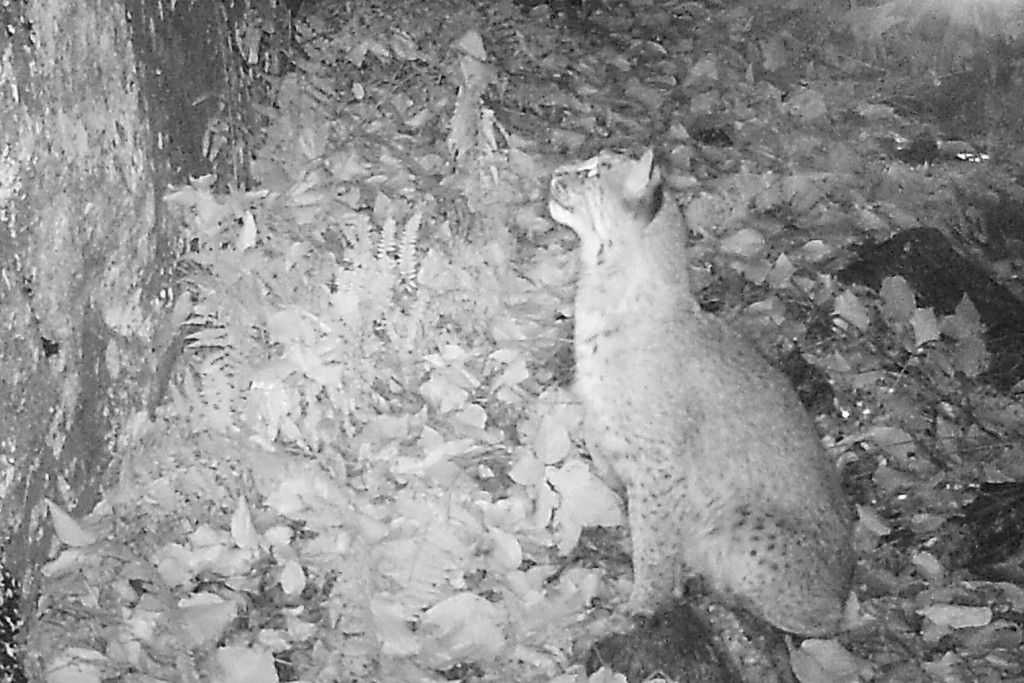
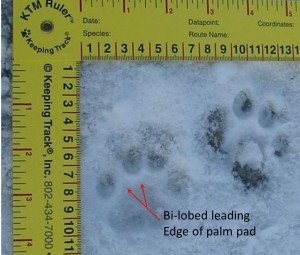
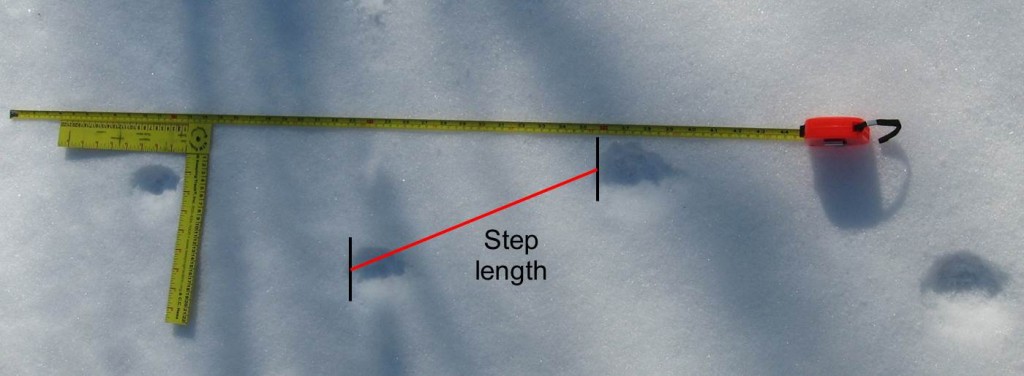
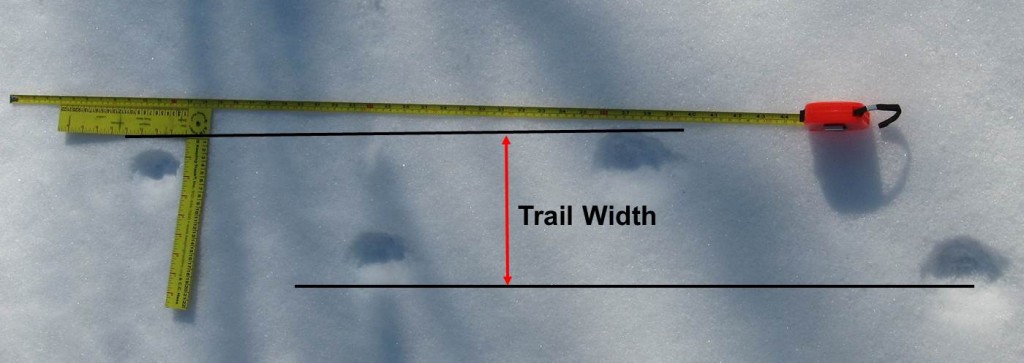
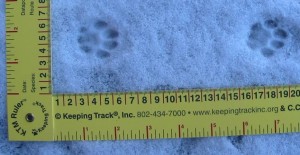
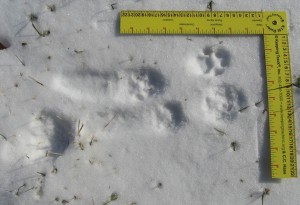
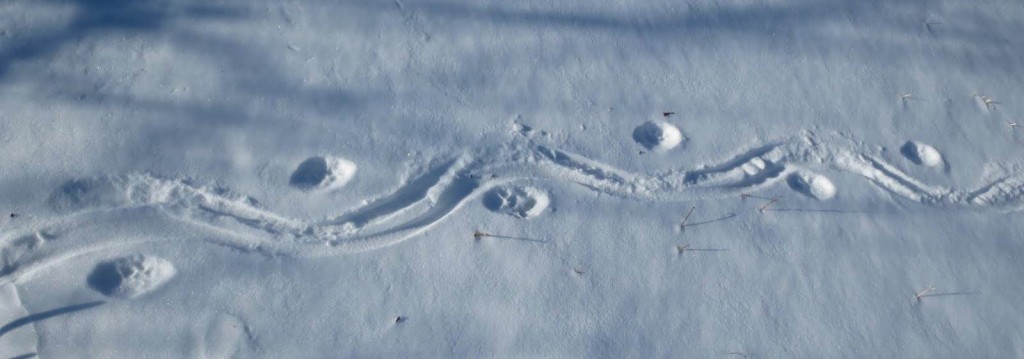

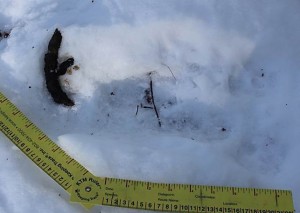
Great post! I love finding prints in the mud as I walk around our place. I don’t always know what made them, but I love trying to find out. I don’t think I’ve seen bobcat tracks, but I have seen a bobcat – one sighting, about half a mile away – he trotted along the side of the road ahead of me, as I drove slowly at a distance behind me. It was so cool. Thank you for sharing this at the HomeAcre Hop.
Thankfulness to my father who informed me concerning this
weblog, this blog is in fact awesome.
thank you!
Thanks for this very thorough and helpful post – you helped me confirm that the tracks I found to day on our pond are bobcat tracks!
Glad it was helpful, Laura. I too was out tracking today, and found bobcat tracks. Always exciting!
We saw a bobcat in our backyard in Littleton this morning. It was unmistakable by the size and the bobbed tail. It looked like it was traveling through, though it did double back towards my yard waste pile. It had fairly good cover due to the double row of hemlocks between my yard and my neighbor’s yard. It was very exciting to see!
Cool to know you saw one in Littleton! While driving through Littleton early in the morning about a month ago, I got a very quick glimpse of what I thought was a bobcat running across the road. It was so quick that I’m not sure, but the only other possibility is a large domestic cat with a stumpy tail.
Where were you driving? I live on Hartwell Ave, close to a conservation area. We’ve had reports of bobcats in town, though not in the neighborhood. It was far too big to be a domestic cat. I’d love to see it again, but I understand that they are shy.
The cat crossed Foster St, between the train station and Taylor Ave. It was either a small bobcat, or a large house cat that happened to have a stump tail, and similar color of a bobcat. It was definitely smaller and more delicate looking than the big one I got a clear look at, here in Bolton. Perhaps I saw a male bobcat in Bolton and a female bobcat in Littleton. Yes, they are shy, but it seems that they are adapting to people, and becoming less and less shy.
Pingback: Poultry Predator Identification: A Guide to Tracks and Sign - One Acre Farm
I thoughtwhat I saw in my backyard in wilbraham was a bobcat but after looking up pictures I think it looked more like a mountain lion ,I know they say we don’t have them , but it was rather large size of a medium dog was tan in color and had a tail .
Hi Michelle, a mountain lion is possible, but unlikely. Based on photos, tracks, and scat, the vast majority of New England sightings which are initially believed to be mountain lion, turn out to be dog, bobcat, or house cat.